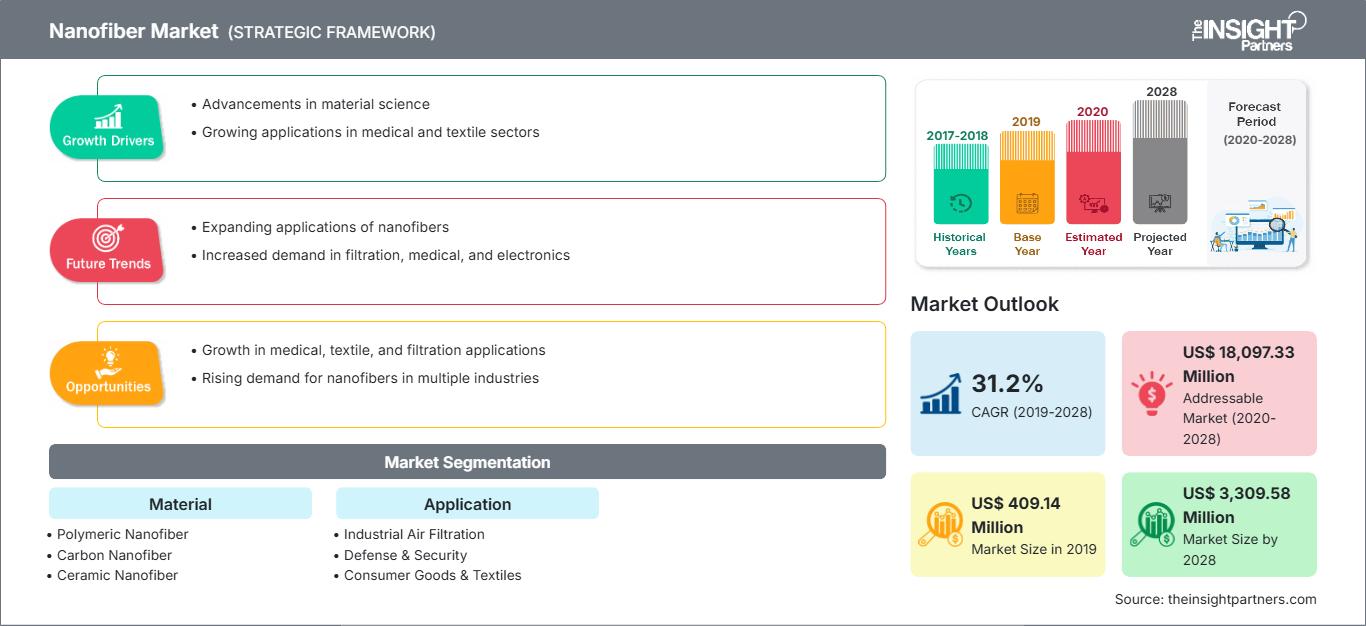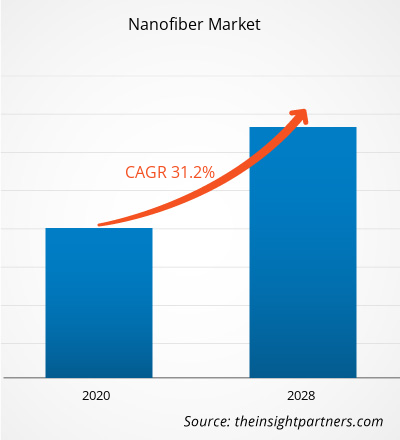Il mercato delle nanofibre è stato valutato a 409,14 milioni di dollari nel 2019 e si prevede che raggiungerà i 3.309,58 milioni di dollari entro il 2028; si prevede una crescita a un CAGR del 31,2% dal 2020 al 2028.
Le nanofibre sono fibre con un diametro inferiore a 1 µm. Queste fibre contribuiscono ad aumentare l'efficienza di filtrazione con una riduzione relativamente lieve della permeabilità. Il rapido ritmo di industrializzazione, la crescente commercializzazione di prodotti in nanofibre con applicazioni industriali in aumento, il continuo impegno nell'innovazione tecnologica e l'aumento degli investimenti in ricerca e sviluppo sono tra i fattori significativi che contribuiscono alla crescita del mercato delle nanofibre.
Nel 2019, l'Asia-Pacifico è stato il mercato più grande per le nanofibre. L'APAC ospita molti paesi in via di sviluppo che stanno assistendo a una forte crescita nel loro settore manifatturiero; la regione è diventata un polo manifatturiero globale. Oltre all'evoluzione della Cina in un polo manifatturiero altamente qualificato, altri paesi in via di sviluppo come India, Corea del Sud, Taiwan e Vietnam stanno attraendo diverse aziende che desiderano delocalizzare i propri impianti di produzione a bassa e media specializzazione in paesi limitrofi con un costo del lavoro inferiore. I governi di questi paesi stanno inoltre accogliendo tali aziende migliorando le idee di investimento o incoraggiando gli investimenti diretti esteri (IDE).
Il COVID-19 ha avuto un impatto negativo sulle economie e sui settori industriali di diversi paesi a causa di lockdown imposti dai governi, divieti di viaggio e chiusure aziendali. Il settore chimico e dei materiali è uno dei principali settori che ha subito gravi interruzioni sotto forma di interruzioni della catena di approvvigionamento, cancellazioni di eventi tecnologici e chiusure degli uffici. La chiusura di vari stabilimenti e fabbriche in Nord America, Europa, Asia-Pacifico, Sud America, Medio Oriente e Africa ha limitato la catena di approvvigionamento globale e disturbato le attività produttive, i programmi di consegna e le vendite dei prodotti. Inoltre, diverse aziende hanno già previsto possibili ritardi nelle consegne dei prodotti e un crollo delle vendite future dei loro prodotti. I divieti di viaggio imposti da paesi in Europa, Asia e Nord America stanno ostacolando le collaborazioni commerciali e le opportunità di partnership. Oltre a queste restrizioni, la limitata disponibilità di professionisti e la riduzione dei livelli di produzione dovuti alle misure di distanziamento sociale sono fattori che ostacolano le attività nel settore chimico e dei materiali, nonché nei vari mercati ad esso correlati. Molti paesi stanno ora tornando alla normalità, mentre molti stanno vivendo una seconda ondata dell'epidemia. Inoltre, grazie alle campagne di vaccinazione, è probabile che la situazione cambi nei prossimi mesi.
Personalizza questo rapporto in base alle tue esigenze
Potrai personalizzare gratuitamente qualsiasi rapporto, comprese parti di questo rapporto, o analisi a livello di paese, pacchetto dati Excel, oltre a usufruire di grandi offerte e sconti per start-up e università
Mercato delle nanofibre: Approfondimenti strategici

-
Ottieni le principali tendenze chiave del mercato di questo rapporto.Questo campione GRATUITO includerà l'analisi dei dati, che vanno dalle tendenze di mercato alle stime e alle previsioni.
Rapido ritmo di industrializzazione e necessità di ridurre le emissioni nocive degli impianti industriali
Il settore manifatturiero globale è in rapida espansione, poiché sempre più regioni stanno investendo nell'adozione di impianti di produzione nelle proprie aree. Secondo la Federazione Cinese di Logistica e Acquisti (CFLP), l'indice dei responsabili degli acquisti (PMI) del settore manifatturiero globale era pari a 55,1 a ottobre 2017, mentre era pari a 55,9 a settembre 2017; tuttavia, l'indice ha raggiunto il suo picco complessivo in questi mesi. L'indice PMI si è attestato a circa 53,5 dall'inizio del 2017, a indicare una solida ripresa del settore manifatturiero nei paesi sviluppati, un crescente progresso industriale nelle economie emergenti e un aumento dei prezzi delle materie prime sul mercato globale. Si prevede che il settore manifatturiero in espansione adotterà i progressi tecnologici per ottenere un vantaggio competitivo, migliorando la produttività degli impianti e tenendosi aggiornato sui cambiamenti nelle preferenze dei clienti. Il settore manifatturiero sta attualmente attraversando una fase di rinascita tecnologica, che sta cambiando le prospettive e i processi della fabbrica moderna. Tuttavia, l'intensificazione delle attività di vari settori industriali sta contribuendo anche ai rischi ambientali, soprattutto nelle città fortemente industrializzate. L'industrializzazione intensiva sta inoltre incidendo sulla salute della popolazione residente in prossimità di queste attività attraverso emissioni tossiche.
Approfondimenti sui materiali
In base al materiale, il mercato delle nanofibre è segmentato in nanofibre polimeriche, nanofibre di carbonio, nanofibre ceramiche, nanofibre di vetro e altre. Il segmento delle nanofibre di carbonio ha guidato il mercato delle nanofibre con la quota maggiore nel 2020. Le nanofibre di carbonio vengono prodotte eliminando gli elementi non carboniosi dai polimeri sintetici e dai biopolimeri a temperature estremamente elevate. Nel metodo di produzione delle nanofibre di carbonio con catalizzatore flottante, vari metalli in polvere o in forma di supporto vengono utilizzati come entità catalitiche. Lamine, garze, fili, ecc. sono altri catalizzatori utilizzati nella produzione di nanofibre. Le nanofibre di carbonio presentano elevata discontinuità e compatibilità, tra le altre proprietà fisiche, e sono anche altamente grafitiche. Hanno eccellenti proprietà meccaniche con elevata conduttività elettrica e termica. I campi di applicazione delle nanofibre di carbonio includono termoplastiche, elastomeri, termoindurenti, ceramiche, elastomeri e metalli. Inoltre, grazie alla loro elevata resistenza alla trazione e alla conduttività termica ed elettrica, le nanofibre di carbonio sono ampiamente utilizzate anche in strutture ortopediche, odontoiatriche e per l'ingegneria tissutale.
Approfondimenti sulle applicazioni
In base all'applicazione, il mercato delle nanofibre è segmentato in filtrazione dell'aria industriale, difesa e sicurezza, beni di consumo e tessuti, componenti elettronici, energia, sanità e scienze della vita, chimica e ambiente e altri. Il settore sanitario e delle scienze della vita Il segmento delle scienze biologiche ha guidato il mercato con la quota maggiore nel 2020. I materiali biodegradabili utilizzati nelle nanofibre sono particolarmente adatti per il settore medico e sanitario. Inoltre, l'integrazione di additivi consente la multifunzionalità di queste nanofibre. Poiché la loro struttura e dimensione possono essere controllate, possono essere utilizzate nell'ingegneria tissutale. Alcune delle principali applicazioni delle nanofibre nei settori delle scienze biologiche e farmaceutico includono la somministrazione di farmaci, la guarigione delle ferite, l'ingegneria tissutale e i tessuti barriera.
Tra i principali attori del mercato delle nanofibre figurano Ahlstrom-Munksjo; Asahi Kasei Corporation; Donaldson Company, Inc.; DuPont; Nanofibers Solution LLC, Inc.; Toray Industries, Inc.; Espin Technologies; Elmarco SRO; Mempro Ltd.; e Revolution Fibers Ltd. Le principali aziende del mercato si concentrano su strategie come fusioni e acquisizioni e lanci di prodotti per ampliare la loro presenza geografica e la loro base di consumatori. Ad esempio, nel 2018, Donaldson ha introdotto un sistema innovativo per semplificare la selezione dei filtri per turbine a gas da parte degli operatori, consentendo loro di selezionare i filtri dell'aria sostitutivi, sviluppando test di laboratorio per quantificare il tasso di recupero degli impulsi e la tenuta stagna.
In evidenza nel rapporto
- Tendenze progressive del settore nel mercato globale delle nanofibre per aiutare gli operatori a sviluppare strategie efficaci a lungo termine
- Strategie di crescita aziendale adottate dalle aziende che operano nei mercati sviluppati e in via di sviluppo
- Analisi quantitativa del mercato globale delle nanofibre dal 2017 al 2028
- Stima della domanda di nanofibre in vari settori
- Analisi PEST per illustrare l'efficacia di acquirenti e fornitori che operano nel settore nel prevedere la crescita del mercato
- Sviluppi recenti per comprendere lo scenario competitivo del mercato e la domanda di nanofibre
- Tendenze e prospettive di mercato, insieme ai fattori che guidano e frenano la crescita del mercato delle nanofibre
- Strategie illuminanti che sostengono l'interesse commerciale per il mercato globale delle nanofibre crescita, per facilitare il processo decisionale
- Dimensioni del mercato delle nanofibre in vari nodi del mercato
- Panoramica dettagliata e segmentazione del mercato delle nanofibre, insieme alle dinamiche del settore
- Dimensioni del mercato delle nanofibre in varie regioni con promettenti opportunità di crescita
Approfondimenti regionali sul mercato delle nanofibre
Le tendenze regionali e i fattori che influenzano il mercato delle nanofibre durante il periodo di previsione sono stati ampiamente spiegati dagli analisti di The Insight Partners. Questa sezione analizza anche i segmenti e la geografia del mercato delle nanofibre in Nord America, Europa, Asia-Pacifico, Medio Oriente e Africa, America Meridionale e Centrale.
Ambito del rapporto sul mercato delle nanofibre
| Attributo del rapporto | Dettagli |
|---|---|
| Dimensioni del mercato in 2019 | US$ 409.14 Million |
| Dimensioni del mercato per 2028 | US$ 3,309.58 Million |
| CAGR globale (2019 - 2028) | 31.2% |
| Dati storici | 2017-2018 |
| Periodo di previsione | 2020-2028 |
| Segmenti coperti |
By Materiale
|
| Regioni e paesi coperti |
Nord America
|
| Leader di mercato e profili aziendali chiave |
|
Densità degli operatori del mercato delle nanofibre: comprendere il suo impatto sulle dinamiche aziendali
Il mercato delle nanofibre è in rapida crescita, trainato dalla crescente domanda degli utenti finali, dovuta a fattori quali l'evoluzione delle preferenze dei consumatori, i progressi tecnologici e una maggiore consapevolezza dei benefici del prodotto. Con l'aumento della domanda, le aziende stanno ampliando la propria offerta, innovando per soddisfare le esigenze dei consumatori e sfruttando le tendenze emergenti, alimentando ulteriormente la crescita del mercato.

- Ottieni il Mercato delle nanofibre Panoramica dei principali attori chiave
- Nanofibre polimeriche
- Nanofibre di carbonio
- Nanofibre ceramiche
- Nanofibre di vetro
- Altri
Mercato delle nanofibre - Per applicazione
- Filtrazione dell'aria industriale
- Beni di consumo e tessili
- Componenti elettronici
- Difesa e sicurezza
- Energia e potenza
- Sanità e scienze della vita
- Prodotti chimici e Ambiente
- Altro
Profili aziendali
- Ahlstrom-Munksjo,
- Asahi Kasei Corporation
- Donaldson Company, Inc.
- DuPont
- Nanofibers Solution LLC, Inc.
- Toray Industries, Inc.
- Espin Technologie
- Elmarco SRO
- Mempro Ltd.
- Revolution Fibers Ltd.
- Analisi storica (2 anni), anno base, previsione (7 anni) con CAGR
- Analisi PEST e SWOT
- Valore/volume delle dimensioni del mercato - Globale, Regionale, Nazionale
- Industria e panorama competitivo
- Set di dati Excel
Report recenti
Rapporti correlati
Testimonianze
Motivo dell'acquisto
- Processo decisionale informato
- Comprensione delle dinamiche di mercato
- Analisi competitiva
- Analisi dei clienti
- Previsioni di mercato
- Mitigazione del rischio
- Pianificazione strategica
- Giustificazione degli investimenti
- Identificazione dei mercati emergenti
- Miglioramento delle strategie di marketing
- Aumento dell'efficienza operativa
- Allineamento alle tendenze normative






















 Ottieni un campione gratuito per - Mercato delle nanofibre
Ottieni un campione gratuito per - Mercato delle nanofibre